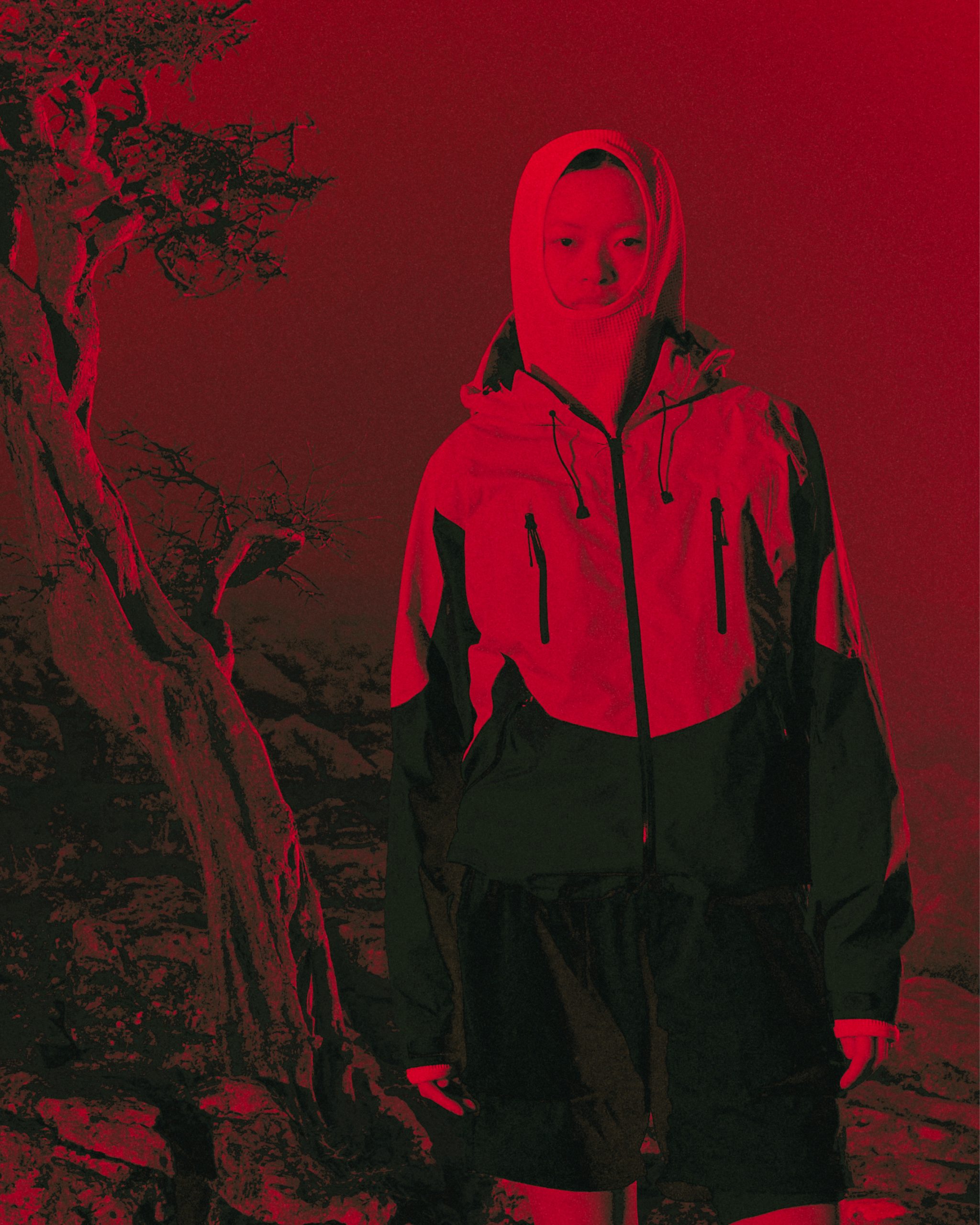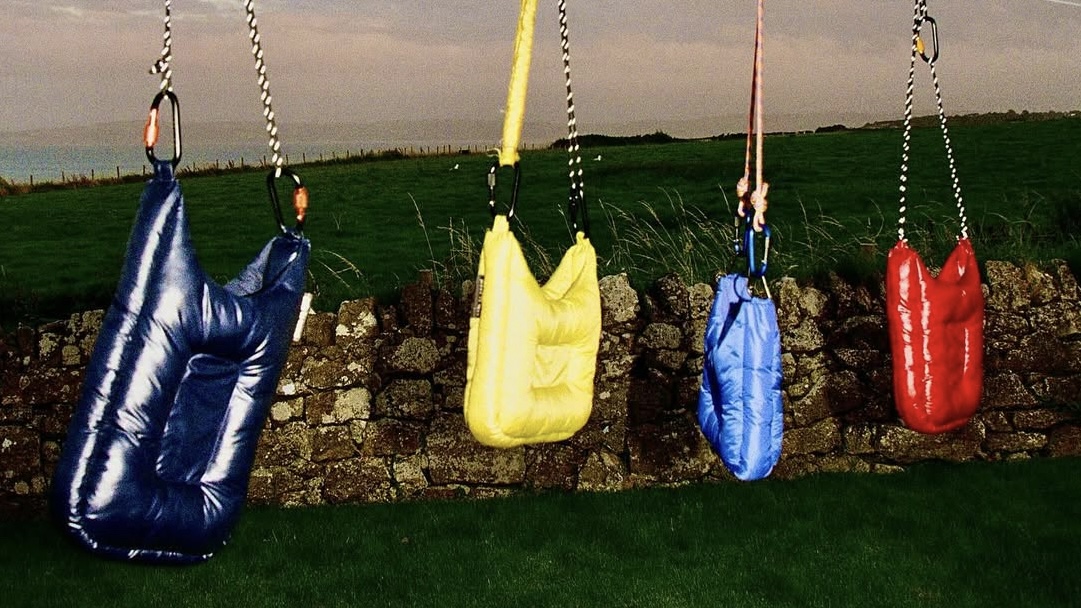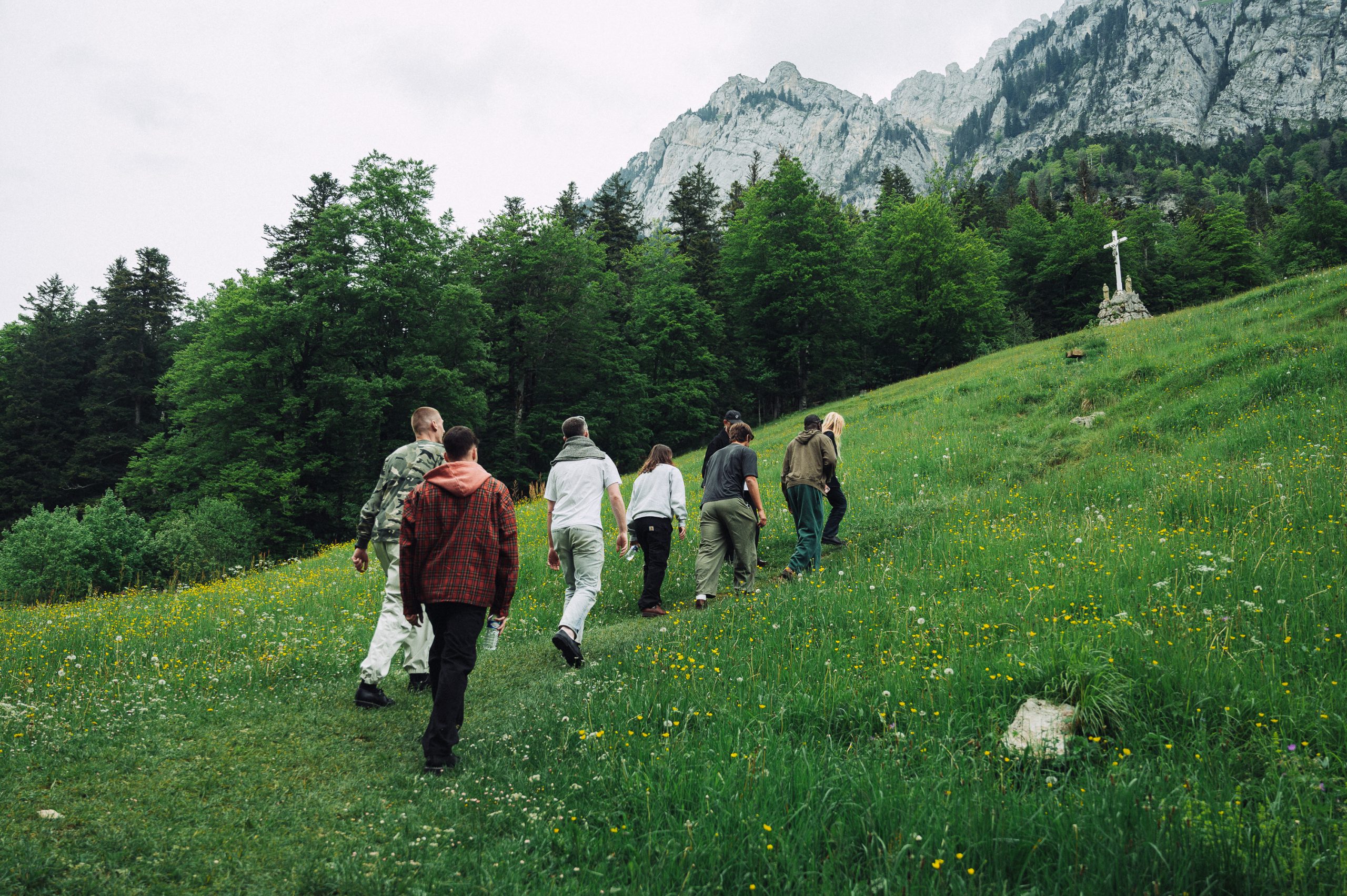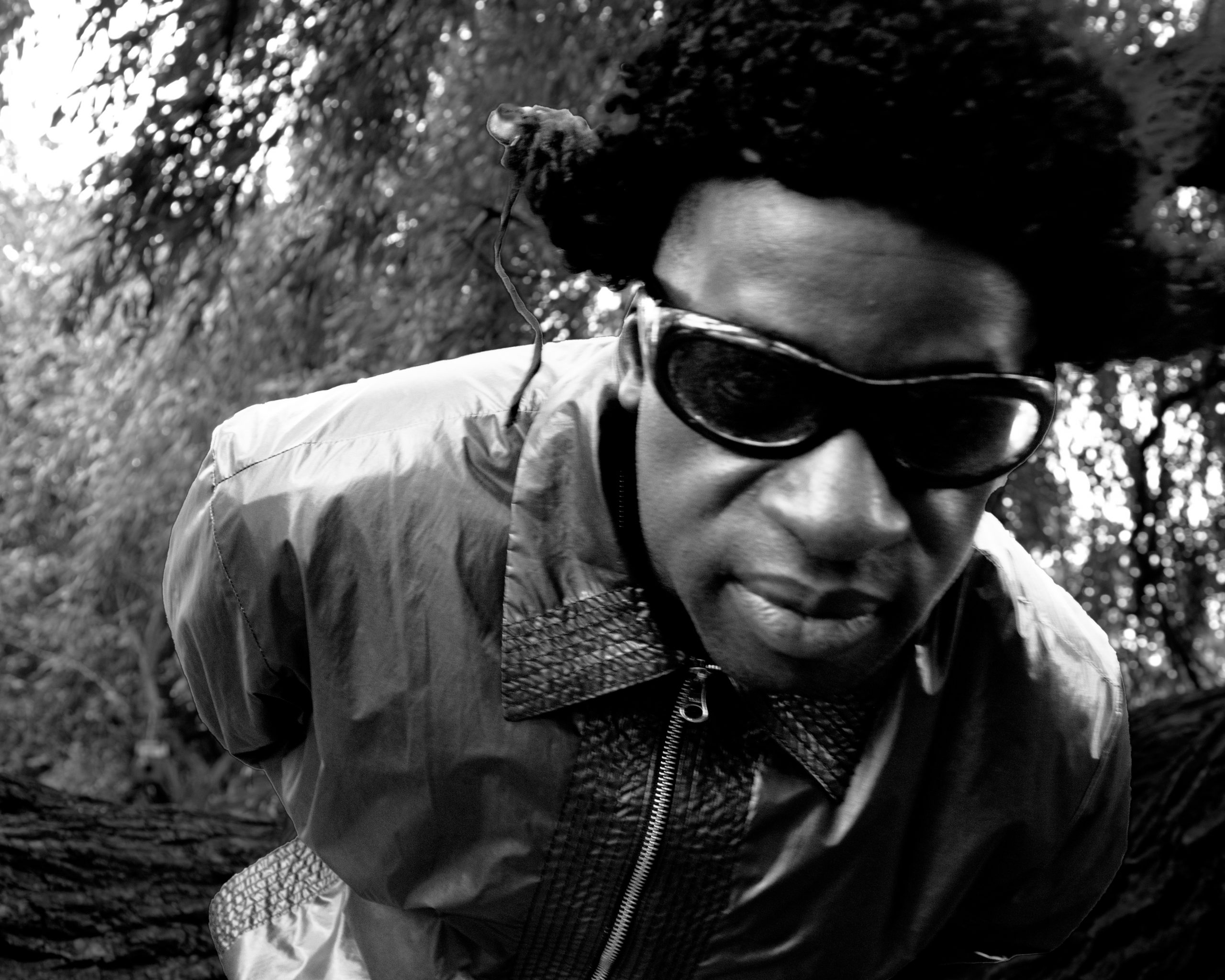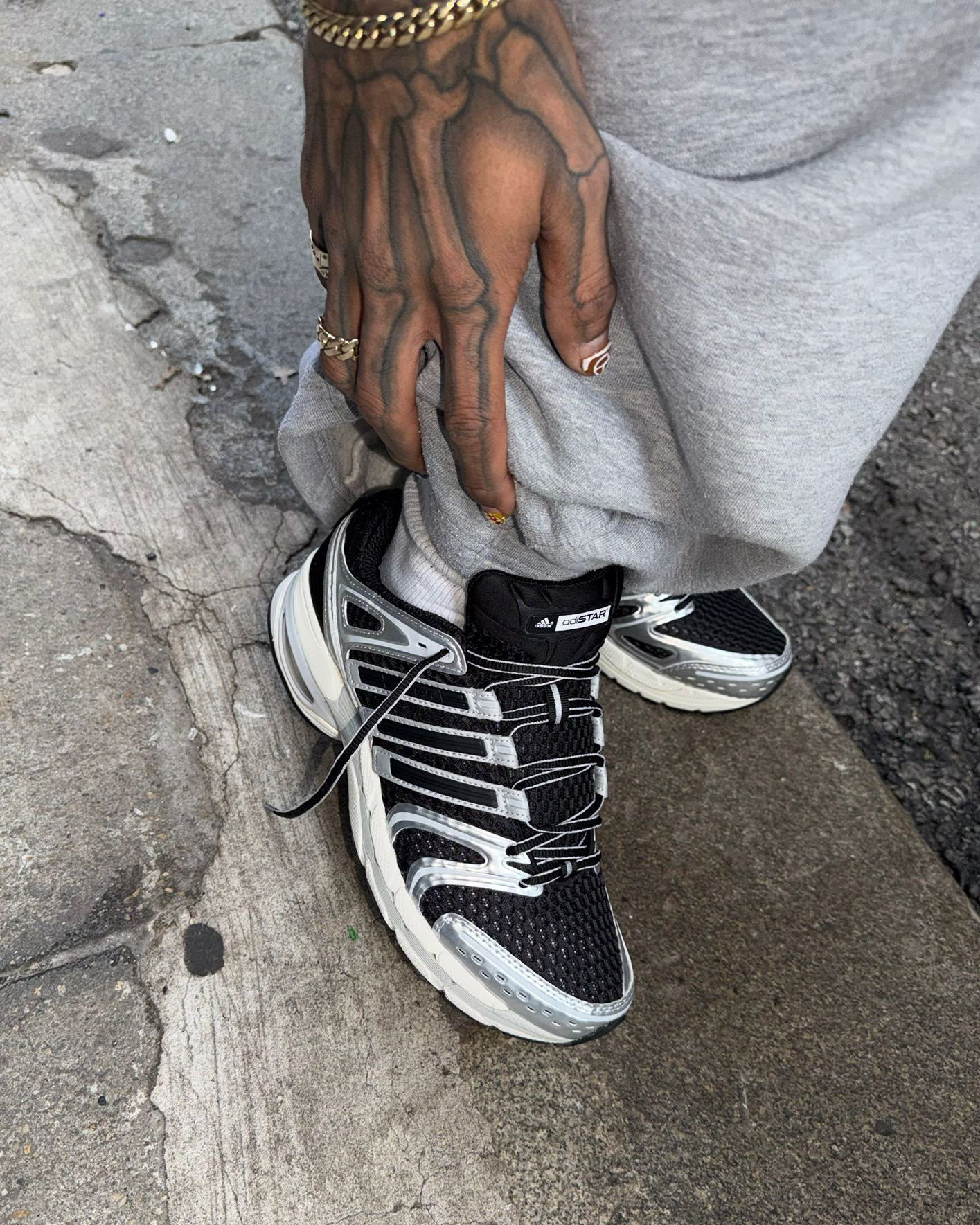Ahead of the 25th anniversary of the iconic ACG Lungs technology, BasementApproved caught up with ACG expert Louis Holsgrove to explore the very best of his personal archive.
Nike ACG is the shoulder that every functional clothing brand stands upon. Long before brands like Arc’teryx, Salomon and The North Face equipped you with the requisite garms for a seamless transition between urban and outdoor environments, Nike ACG was pumping out unprecedented and experimental all conditions gear.
The Nike ACG timeline is varied and complex. Decades worth of different designers have left their imprint on the brand, tweaking things like zips and fasteners and cuts and fits; a hyper-focus on the intricate details defining a Swoosh sub-studio that met the needs of Gorpcore aficionados long before the term was coined. Design features operate as a form of language, like tell-tale signs that begin to build a story. Learning this language has become a hobby for many ACG enthusiasts, and an entire lifestyle for some.
Basement community stalwart, Louis Holsgrove is a collector and reseller of ACG. He has been collecting for five years, during which time he has amassed an archive with variety and depth to challenge the very best of them. His commitment speaks for itself.
In order to celebrate a small period in ACG history – the Lungs era – Louis interviewed several key designers and styled an exclusive editorial using items from said archive. “The main reason for the editorial,” Louis says, “is to showcase key items from the Lungs era, accompanied with information on the design. It is near impossible to find details online. I want to share some knowledge and shine light on the beauty of the Lungs era. The editorial showcases eighteen looks made up of only Lungs pieces from my collection and represents them in the way I feel they should be worn.”
Before we can understand the Lungs era, we have to go back to the late 1970’s, when ACG’s origin story begins. In 1978, a photo of Rick Ridgeway and John Roskelley climbing K2 (the second highest mountain in the world) started circulating in the pre-internet world. They weren’t wearing hiking shoes. They were wearing yellow Nike LDVs.
The question for Nike was simple: why are these mountain climbers wearing lightweight running shoes in conditions that typically demand reinforced support?
Ridgeway and Roskelley belonged to a group called The Stonemasters. They were cultural antagonists. Climbers before them preferred to wear dull colours. The Stonemasters preferred bright. When traditional climbers wore reinforced leather boots, the Stonemasters wore lightweight runners. They abandoned safety ropes and free climbed rock faces with the taste of danger in their mouths and lactic acid building in their lungs.
What they did for Nike, however, was pioneer a new target market. Nike responded in 1981 with three legendary trainers: the Lava Dome, the Magma, and the Approach. The Approach is explicitly important for being the world’s first shoe to incorporate a revolutionary new material: GORE-TEX.


This range formed the foundation for Nike Hiking, which, due to expansion, came to highlight a timeless rule in branding: never let a name box you in. The Hiking range found its footing not just within the hiking contingent, but proved popular among kayakers, mountain bikers and trail runners. In ‘89, Nike Hiking rebranded to become Nike ACG – All Conditions Gear.
The ACG design team devoted themselves to the design and production of lightweight, functional and bold silhouettes – shoes that accepted their role as outdoor attire, but ushered the wearers into a jovial and buoyant community. ACG also opened the doors for Nike’s production of weatherproof clothing, and their dabbles with GORE-TEX found new life in heavy ski jackets, lighter windbreakers and everything in between.
In 1991, Tinker Hatfield – a man whose influence in the world of shoe design is remarkable – designed the Air Mowabb. A fusion of the Wildwood and Hatfield’s similarly revered Swoosh silhouette – the 1991 Huarache (Tinker was busy that year) – the Air Mowabb is the embodiment of ACG’s entire brand ethos. An outdoor cross-trainer, with a speckled outsole inspired by the iridescence of rainbow trout, the Air Mowabb’s infamous advert asks you to challenge your outdoor commitments. Mobile phones, Bauhaus architecture and the chance you might meet someone you owe money to are reasons to leave the city. If you get outdoors, says Nike ACG, you can even wear a pair of Air Mowabbs.
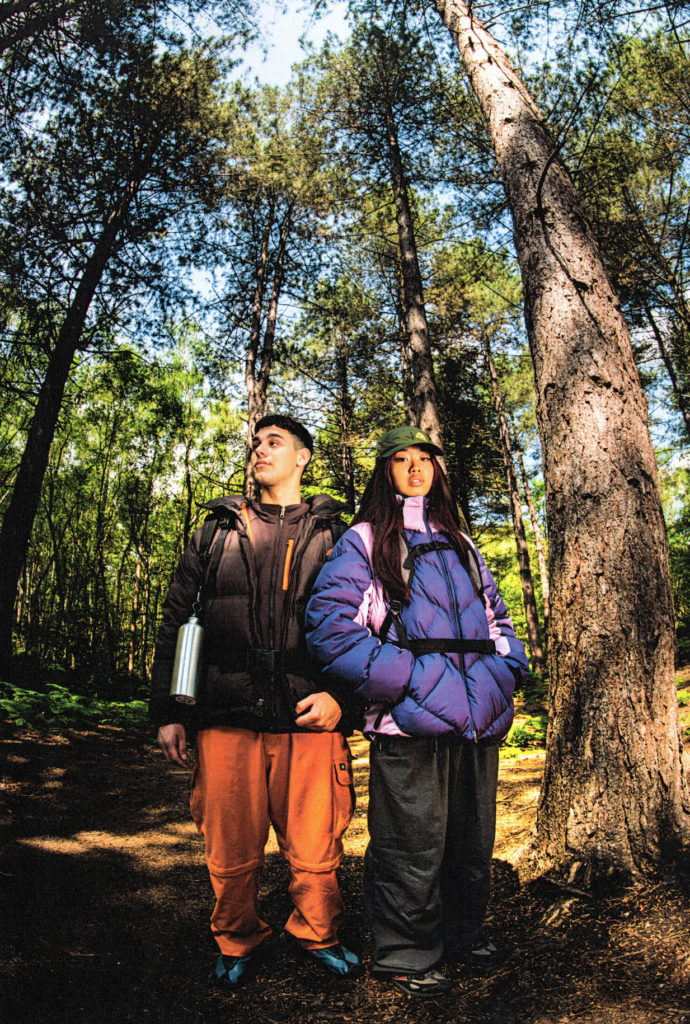

This sort of advertisement was typical of ACG at the time: the adverts addressed you directly, sometimes even pointing a finger at you, making you question yourself. If you want to stay sane, suggests ACG, the best way to do so is by screaming down mountains, scrambling over boulders and plunging into rivers. ACG wasn’t and isn’t just a clothing line for the outdoors. It’s a lifestyle commitment; one which continues into 2021 with the most recent ACG tagline ‘Get Out, Get Lost.’
Until the mid 90’s ACG was explicitly flamboyant. Their fleece lines, with input from Patagonia’s designers, featured heavy and bold colour blocks, often contrasting and always vibrant. In the latter half of the 90’s, ACG’s outlandish colours were toned down, and in 1997, ACG entered what collectors call the Lungs era. The Lungs Era, aesthetically characterised by a logo formed of two triangles that resemble lungs, bolstered by a central swoosh, is considered by many to be a golden age of Nike design.
“I love the Lungs Era ACG and what it stands for. The single triangle logo has amazing heritage and countless great pieces were produced around that time, but the Lungs era is so special to me,” reflects Louis. After encountering a Lungs era ACG jacket in 2016, Louis has been “addicted” to exploring the history of the brand.
The Lungs era marked a transition away from the colour-block heavy ACG of the past. The change was gradual and dynamic. The early half has more in common with the ACG of the 90’s, while the latter half forms the foundations for what we recognise in techwear today: sleek, ergonomic and stealthy functionalism. The second half of the Lungs era was markedly more city-orientated, and because of this, has found itself more easily incorporated into streetwear; an infusion of form and function that remains a steadfast fixture of fashion as we know it today.
Jackets became more tech heavy. As well as building on Nike’s 30 year relationship with GORE-TEX (Nike was one of the first companies to acquire commercial orders in 1979, team early!) ACG introduced their in-house Storm-FIT in 1996. Storm-FIT – a microfibre layer of polyester coated with breathable laminate – functioned similarly to GORE-TEX, but thanks to in-house production, was cheaper, and therefore opened the ACG line to different markets. In a situation where GORE-TEX’s full capacities weren’t necessary, Storm-FIT would suffice. Still waterproof, still breathable, but a fraction of the price.
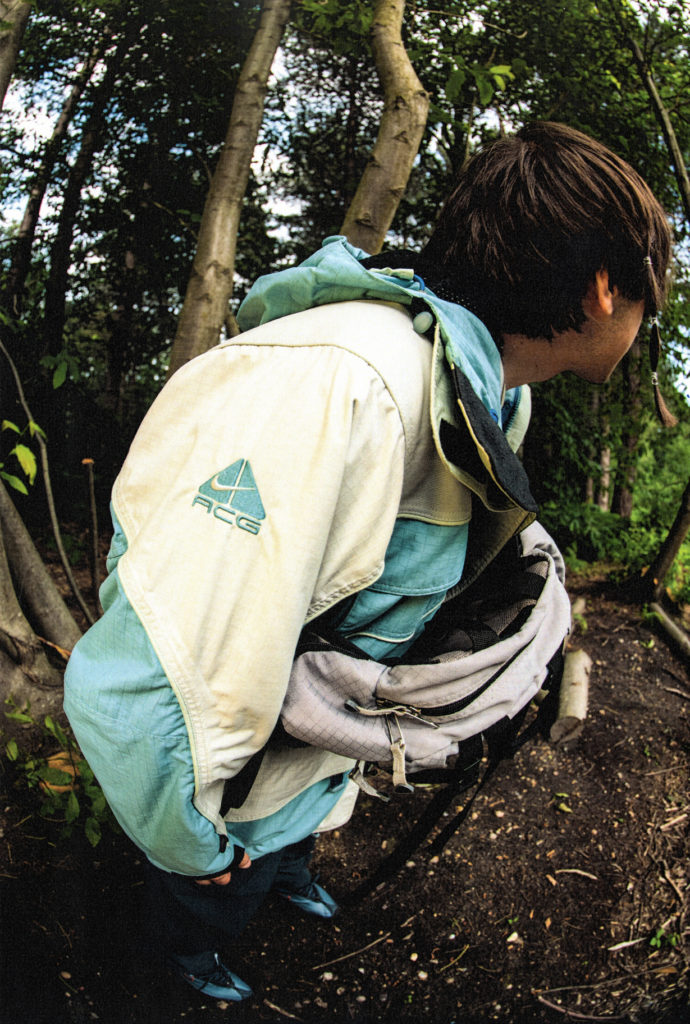
For serious mountain climbers, ACG began to incorporate RECCO technology into their outerwear. A system that enables your jacket to respond to radar projections, meaning that if (God forbid) you were lost 200km away from civilization, your jacket could function as a means to locate you, by bouncing and redirecting signals back to the sender. It’s like SETI, except rather than shooting signals into space, they’re being shot into the Lake District or Utah’s Rocky Mountains.
George Nelson joined ACG in 2004 and designed one of the first RECCO jackets. Reflecting on the team at the time while speaking with Louis, Nelson is nostalgic. With a studio off-site from Nike’s Oregon campus, the ACG department – like The Stonemasters that influenced them – was built of a set of design renegades and played by their own rules. “We could kind of do whatever we wanted at ACG,” says Nelson, discussing the freedom of design and creative lust. “We had a saying: it’s better to beg for forgiveness than to ask for permission. If you spent your time asking for approval for a project, the answers would be no, or they [the leadership team] would take too long to get back to you.” The spirit of ACG was gusto and vigour. The design authorities at Nike may regretted coining the Just Do it! slogan back in 1988.
Nelson’s RECCO jacket, known as the ‘Sabotage’, features a faded gradient zipper and detailing which was inspired by a company trip to Sweden. Stuart Horner, Design Director at the time, instructed the ACG team to cross the Atlantic so that they could take inspiration from the deep cold and the blend of nebulous colours contained in the Northern Lights. A women’s version of this outerwear jacket, designed by Michelle Nelson (no relation to George) features the same ACG braille detail on the left chest, and can be seen in Louis’ editorial.


“Nike pulled ACG out of the North American market in the early 2000’s, so most of the designs were led by Europe and Asia. ACG was really hard to come by during this time. We rarely saw the final pieces we designed in retail,” says Nelson. At the same time, Nelson was designing up to 70 pieces of apparel per season, meaning that the team was pumping out huge rates of clothing that they never saw brought to life. It’s thanks to this that there seems to be an unlimited amount of ACG out there, and collectors dig through the variety of niche, experimental and one-off releases with enthusiasm, like pirates looking for treasure. “Many of the products we designed didn’t even have names,” says Nelson, which has led to collectors naming pieces themselves, like the coveted ‘Ninja Sherpa’ seen in Louis’ editorial.
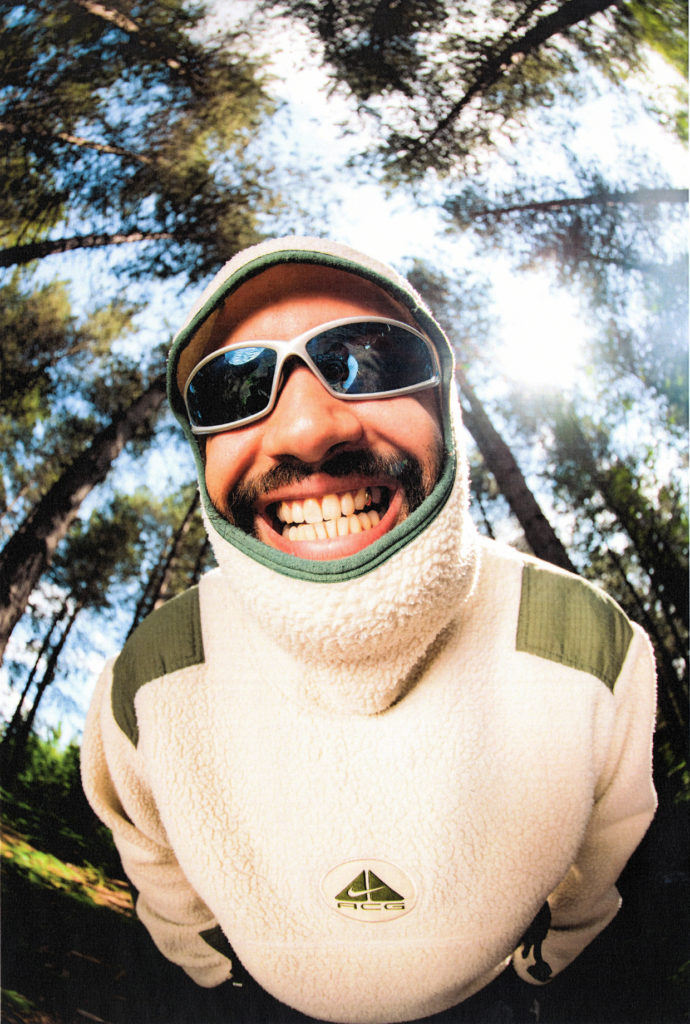
Tech advances during the Lungs era also include therma-fit fleeces, dri-fit underlayers, fully gusseted footwear with central zips and neoprene rubbers to block out debris, 3M reflectives, 3M thinsulate, and a whole host of wild abbreviations that might as well be hieroglyphics.
ACG carried out all these material and design advances with steeze and subtlety. The use of magnets for closures was – and still is – innovative; jackets and fleeces have nylon woven overlays on the shoulders to create added padding where backpacks or straps might rub; taped seams, snowskirts, breathable vents and laminated hoods cover all possibilities.
In 2008, a jacket designed by Peter Valles was released using an inflation toggle to harness the power of air for insulation. “We were approached by GORE-TEX to trial it,” Valles remembers. Some of the stiffer GORE-TEX jackets inhibit movement, so the idea is that air, especially if you can adjust it when necessary, will work with the movement of the body. “Air is the lightest and best insulator,” says Valles. Valles designed the body of the jacket and patterning, while Shane Kohatsu designed the inflator. The jacket is best known as the AirVantage and released in three colourways: jet black, green and yellow.

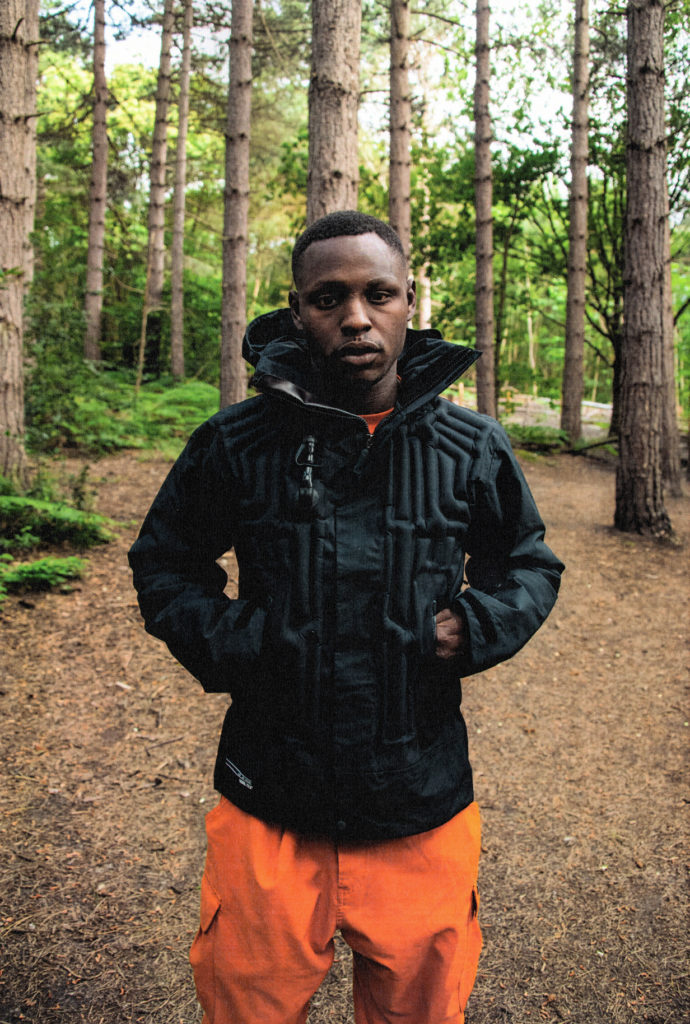
“The AirVantage jacket is one of my favourite pieces ever,” says Louis, who has styled one of each colour with baggy fitting ACG cargos and nylon pants. The jacket’s inflation system forms contours that rise and fall like a topographical map. “When I first bought one I had no clue they were inflatable,” recalls Holsgrove. “I found the nozzle and blew into it out of curiosity. From there on I was sold on the brand.”

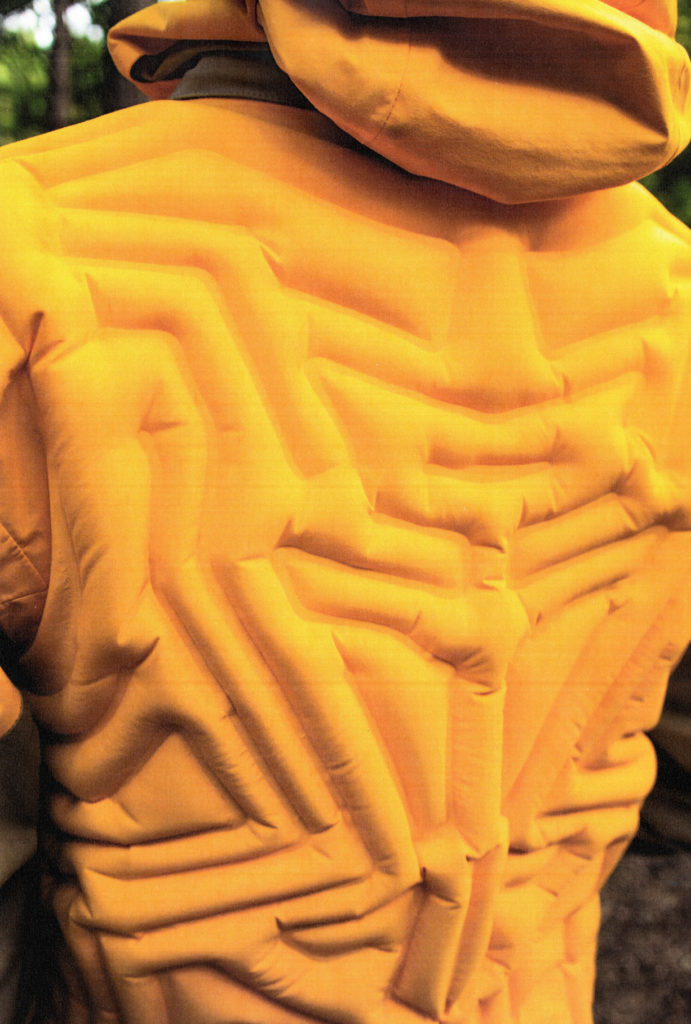
Clothes from the Lungs era reveal themselves to you as you wear them. Nothing prepares you for the realisation – maybe something so subtle that you don’t realise it until months of wear – that takes place when a detail comes to life. Prepare for multiple ‘that’s why this is there’ moments. A particularly hot day, when a quizzical zip releases a vent and a cool breeze embraces you as you scan the vista. They’re the type of clothes that fill you with perplexion as you slowly realise that a designer, somewhere, thought about this exact scenario, and you, in wearing the clothes in the right place at the right time, are realising the products intended use in realtime. Synchronicity between designer and user which remains unmatched.
Alongside the outerwear, ACG’s footwear department is responsible for countless influential designs. Some landmarks include 1995’s Air Moc, designed by Torn Orzeck – a shoe that has seen countless rebirths and is largely the influence behind the recent trends towards down-filled shoes. Several years later, in 1997 and right on the cusp of the transition into the Lungs era, Orzeck, with a background in plastic technology, went on to design Nike Foamposite, a material that’s poured into a mould and set. It has been reiterated into basketball trainers and running shoes countless times. The following year, Sergio Lozano designed the Air Pocket Knife – so called because it folds in half. Lozano is now best known for designing the Air Max 95.
Importantly, when people think of ACG’s footwear, Peter Fogg’s futuristic sketches of 2003’s Nike Air Zoom Tallac summarise ACG’s pioneering approach. “The Tallac changed the hiking boot world,” claims Fogg. It was the first shoe to harmonise the ankle support of a boot with the lightweight frame of a low-cut hiking trainer. A featherweight upper is reinforced with a thermoplastic urethane exosteleton; a Zoom Air bag cushions the midsole; GORE-TEX lining keeps liquid out. The Tallac is a truly functional trainer designed with the outdoors in mind. When it comes to designers, ACG was a magnet for the sort of person you can imagine as a descendent of Einstein, with one hand in the future, and the other, in the days before CAD modelling, erratically sketching silhouettes throughout the night.
Several key shoes are featured here in Louise editorial. 1998’s beige Air Gimli builds on the inspiration behind the original 1981 Magma. 2001’s Air Terra Contego features a central zipper and storm shield in a rare light blue/navy colourway. 1999’s Air Exploraid has a honeycomb print sole that is shot beautifully from underneath. There are so many releases of ACG footwear that collectors have trouble keeping up with all the variety; dating and identifying key pieces is a skill that is developed through community. ACG enthusiasts take time to learn the language of design, spot unique details and use these to trace models and history.



“Nike is a revolving door,” asserts Nelson, explaining that so many designers moved in and out of departments that it became hard to keep track of influence – even in-house.
Bill Cass joined Nike in 1996. “I remember sitting in a meeting where some of the best designers in the industry flooded a 20 person table with concept drawings. Leadership couldn’t find a direction. I don’t think Nike knew at that time that they had something special with ACG.” Cass, like Nelson, praises the rebellious energy which propelled the team at ACG to consistently think outside the box. “I fit right in,” he says. Cass went on to design the Sawtooth – a shoe that almost lost him a job. “Monty Mako tore me up in front of the group because I took two extra days to finish my work. I was pissed but there was so much detail in those shoes. I couldn’t have gone any faster.” When the shoes arrived from the factory, they were pristine, and Mako apologised, granting Cass any extra time if it meant the shoes were finished to that same standard. Cass also designed the Air Trigo after sketching it late at night onto a napkin at a bar. ACG’s history is unorthodox.
Between 2008 and 2014, ACG operated in a sort-of dark period. ACG’s founder, Steve McDonald, left in 2008, roughly where we draw the end of the Lungs era. Consumer trends changed, target markets shifted, and the steady stream of creativity seemed to dry up. “ACG got swallowed up by action sports,” remembers Nelson. “Nike took SB and ACG and tried to combine the two teams. This was in fall 2010 – or maybe holiday 2011.” Both the footwear and apparel teams – who previously worked separately – were pushed into the new Action Outdoors department. “This was supposedly the next big thing. It became painfully apparent to us that there was no intent on continuing with ACG.” Designers were repurposed into SB and 6.0. “It was a mess,” says Nelson.
By 2014, urgent action was needed. Errolson Hugh – a designer dubbed by GQ’s Chris Gayomali as a “time-traveller sent back from the end of the world” – relaunched ACG as NikeLab ACG. The designer, whose own brand ACRONYM has been setting the bar in high-fashion techwear since 1994, boasted recommendations from Stone Island cult-favourite Paul Harvey, who on leaving Stone Island in 2005, approached Errolson to be part of the resurgence team that founded Stone Island Shadow Project. Errolson is a man whose vision knows no bounds. The question was: is Errolson’s vision compatible with ACG’s?
“It was more of a collab between ACG and Acronym,” says Nelson. “It became sort of urban ninja wear. It was good stuff, but far from what ACG was doing.” Errolson steered ACG away from its colourful origins, and weaved it into his own utopian vision. The items were monotone, no tape was left un-seamed and GORE-TEX formed the foundations for inner city armour. Errolson’s creative direction was undeniably designed for all conditions – but some argued that it wasn’t ACG. It was too much of an aesthetic jump and lacked the irreverent nature ACG was built upon.




Despite this shift in tone, Errolson maintained the experimental ethos of ACG. He took ACG down a path that it hadn’t explored yet. What’s more comforting for the all conditions enthusiast? The well trodden path, laden with footsteps and lined with dust, or unexplored territory, tempting and dangerous?
Hugh’s last collection went live in 2018 and he passed the torch to James Arizumi for 2019. Arizumi, moving to the reborn ACG from Nike SB, with a background in footwear design for Nike Golf, knew a thing or two about performance footwear. His approach was to get back in touch with ACG’s colourful origins. Arizumi’s ACG brings the inspirational feeling that characterised early ACG back to the forefront. He challenges you. He preaches the virtues of the wilderness. The great outdoors, says Arizumi, are yours for the taking.
Importantly, ACG’s worth is contained in its ability to showcase, highlight and pioneer not just a brand but a lifestyle. ACG is an approach to the world: a challenge yet to be accomplished or an experience yet to be lived. ACG is rebellious, a stone-master, who knows that what she wants is at the top of a cliff, contained in the white swash of a river, or dangling at the end of the horizon.
Louis’ editorial, shot in a pine forest just outside of London, continues that spirit. Fond of Arizumi’s ACG, Louis would still “like to see a Lungs revival. I think re-releasing old pieces could jeopardise the legacy. I’d like to see a throwback to the Lungs roots with looser cuts, different materials and attention to detail. I really appreciate designs like the two-in-one and three-in-one jackets. They’re super technical but at the same time quite simple. On the opposite end of the spectrum, the Hydration Vests have so many crazy features and the quality is insane. They’re one of those pieces that’ll still hold up after 50 years. They’re indestructible.”

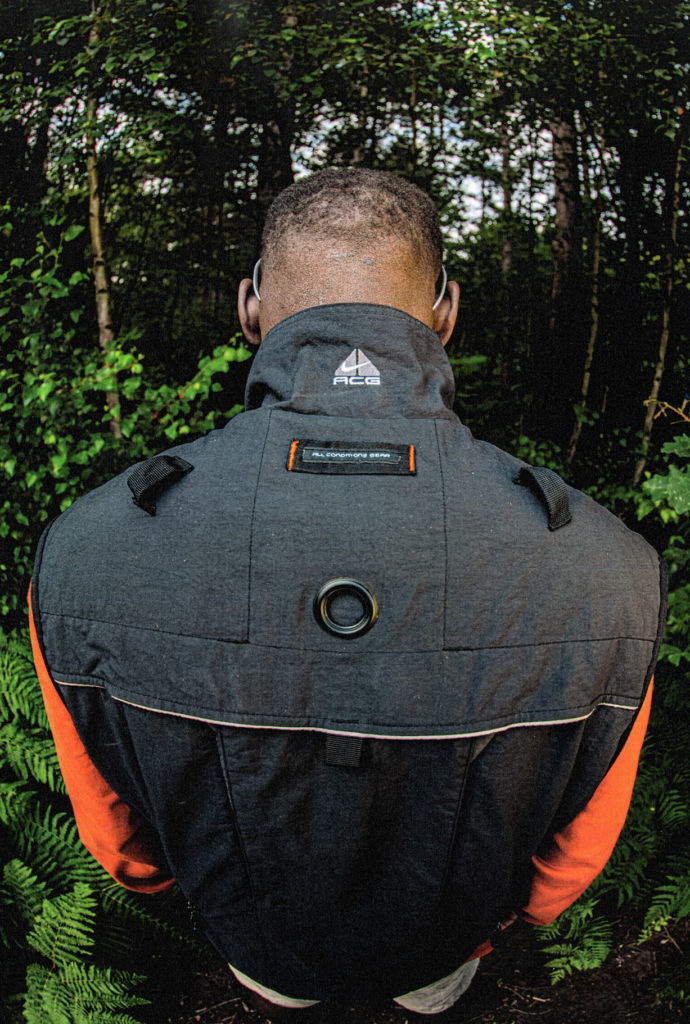
2022 will mark the 25th anniversary of the Lungs era. “I’m hoping the editorial inspires Nike to reconsider the baggy, loose fitting silhouettes that ACG used to have. I’d also love to see them delve deeper into producing more footwear that takes inspiration from late 90’s and early 00’s pairs.”
Valles can see the Lungs logo making a return, perhaps in a one-off release to celebrate heritage. Nelson is less hopeful: “the ACG team had been wanting to make a transition from the Lungs logo back to the triangular logo for a long time. Lots of the designers weren’t huge fans of that specific logo – part of it being that the logo had the swoosh embedded within it.” The triangle logo better represented the rebellious departmental distinction that made ACG.
Fogg is ambivalent: “so much leadership changed at ACG. There were lots of logo options.” Fogg makes the case that the design differences were too varied to be tracked by a logo. The Lungs era may be characterised by the same logo, but the internal variations from year to year and team to team far outweigh anything else. This, combined with Nelson’s case that Nike is a high turnover revolving door, undermines the idea that the Lungs era – on a whole – was a golden era, but just a moment in time or a point on a map.
Nevertheless, the announcement of Hatfield’s Air Mowabb 30th anniversary rerelease for later this year reminds us that anything is possible. Let us hope that the rebellious spirit remains strong in the gut of team ACG, and that there’s still designers content to beg for forgiveness, rather than ask for permission.
Written By
Jacob Negus-Hill
Photography
Daniela K Monteiro
Photography Assistant
Jack Dempsey
Creative Direction & Styling
Louis Holsgrove
Models
Megan Trong
Juan Lopez
Hannah Da Silva
Giorgia Aubrey
Daryon Morgan-Impey
Louie Cresswell
Production
Harriet Russell
Paolo Cimarra
Joe Sparks
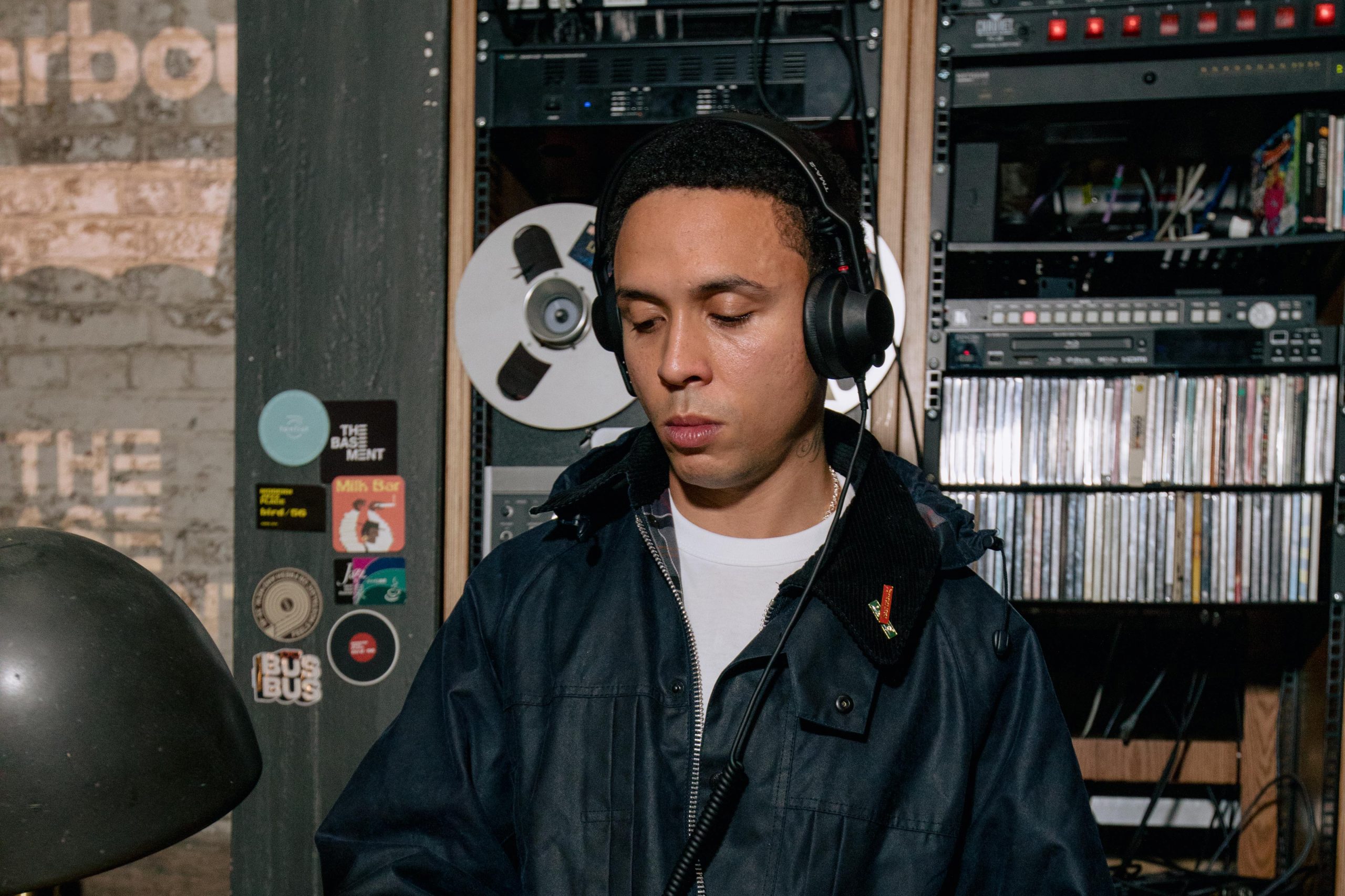
What Went Down: The Basement Presents Barbour x Levi’s® Launch Party
- Community
- Photo Series
- 4 minute read

